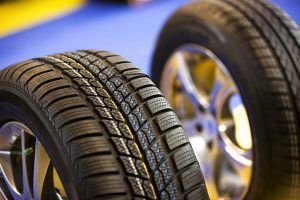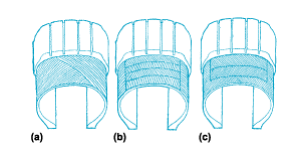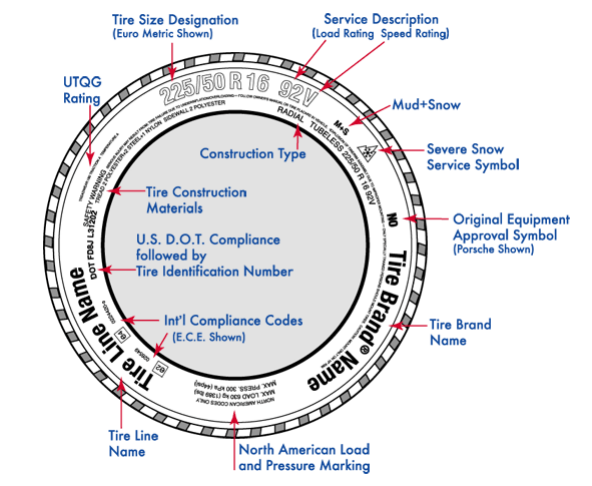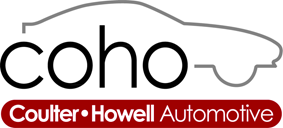Car Tire Maintenance
Car Tires - Everything you ever wanted to know.
Tire shopping can be a confusing because of the jargon used by sales people, it can also be an overwhelming process with the large number of tire manufacturers and selection of tires, and the seemingly limitless variables in tire specifications. Oftentimes, people would end up making a choice based on price and/or availability, out of frustration. Since it can be somewhat daunting, we thought we’d try to de-mystify the process by explaining how tires are constructed, decode what all the numbers and markings on the sidewall mean, and explain some of the most commonly used tire terminology. We’ll also cover the basic information you’ll need in order to select the right tires for your car(s) as well as how to properly care for them.

Car Tire Basics
Car tire maintenance in Manassas, VASimply stated, a tire is a flexible, cylindrical container that holds compressed air. This air container supports the car’s gross vehicle weight, allows the vehicle to move, turn and stop, and cushions it from the road. Every move a driver makes with the steering wheel, brake or gas pedal, for instance, is transmitted to the road through the four notepad-sized contact patches of the tires. This is why tires are one of the more important safety features on cars – they are the vehicle’s only contact with the road. So when tires are worn, under-inflated, or not suited to the environment, it puts the driver, their vehicle, and others at risk. Even the most advanced brake systems or most sophisticated anti-skid system cannot work as designed if the tires can’t grip on the road.
All tires, including the spare, must be regularly checked to ensure that the influences of time and mileage, fluctuation in ambient temperatures or punctures haven’t caused the air pressure to change. Needless to say, maintaining correct tire pressure is the most important thing you can do to prolong the life of tires. It not only stabilizes the tire’s structure thereby reducing tire deflection (flexing of the tread and sidewall), which can generate heat and prematurely induce tire wear, but it helps optimize your vehicle’s performance with respect to fuel economy, improves handling and steering input extends tire life and allows drivers to ride in comfort. For these reasons, we recommend checking tire pressure at least once a month.
Anatomy of a Car Tire
A lot of research and development has gone into tire manufacturing since Ford introduced the Model T. Car tires today are built from the inside out rather than the outside in, may contain more than two hundred different kinds of raw materials, and have between 19 and 25 different components; e.g., steel, fabrics, rubber, etc., all in an effort to provide the best performance and fuel economy. Unlike tires of the past, which consisted of an inner-tube, all modern tires press against the wheel to form a seal without the use of an additional air chamber.
As previously stated, an inner liner is at the heart of every tire. It shapes the tire and gives it the ability to hold air. The main body of the tire is constructed of rubber-coated fabrics called plies. The plies are covered with belts constructed of steel, which is then covered with a heavily woven fabric usually made of nylon. All of this is connected to a bead wire (a hoop-like structure made of steel) that holds the tire on the rim. A layer of rubber that forms the sidewall and tread covers this structure.
Tires have three types: bias, belted bias, and radial (see illustration). Bias tires have cords that extend diagonally in the plies, from bead to bead, across the tire. The cords result in a crisscross pattern, running in opposite directions in each successive ply. On belted bias tires, belts of the material is placed circumferentially around the tire, between the tread rubber and the plies, which is similar to what is used in the bias-ply tire.

You’re probably already familiar with the term radial tires as most late model cars use radial ply tires. Radial refers to the reinforcing cords within the tire that are aligned with the radius of the outer diameter. Stated another way, cords in the plies spread transversely from bead to bead which is perpendicular to the direction of travel. Belts are then placed circumferentially around the tire. With radial ply construction, better handling, reduced rolling resistance, and a longer tire life are achieved.
Replacing Car Tires
Car tires should be replaced when their natural lifespan has come to an end – or five years whichever comes first. However, most consumers make the mistake of waiting until spring to get new tires. As a tire wears out, dry traction generally increases, but wet and snow traction decrease, which can be problematic during the winter months. This is yet another reason why it’s so important to regularly check the condition of your tires.
Some of the factors that can affect when tires need to be replaced include mileage, temperature, condition of the roads, how aggressive the driver is, storage, punctures, etc. There are also a number of indicators which reveal when it’s time to replace your tires. One is when they no longer feel safe to the driver. Another is when they are legally worn out. This can be easily seen by looking at the tread wear indicators or using a tread depth gauge. In Virginia when any part of the tire is less than 2/32 of an inch at two adjacent grooves in three equally spaced locations (for a total of six measurements), it is worn beyond the legal limit and should be replaced as soon as possible.
When in doubt, replace your tires with the same size, speed rating, construction and type as the OEM tires that came on your vehicle when it was new. This information can almost always be found in the owner’s manual and on the driver’s side door/pillar. Curry’s usually suggests buying the same “kind” of tire recommended by the manufacturer’s tire and automobile engineers – they are, after all, the best in the business.
As the TireRack.com graphic below illustrates, the sidewall of your original-equipment tire (and all tires) has a series of codes that explains the tire’s size and capabilities.

Regardless of a tire’s speed rating, load-carrying ability, size, and construction, traction are the keys to safety. A common mistake is to select a tire without considering its ability to hold the road. Passenger-car and light-truck tires are very different. Pickup and SUV owners will generally select passenger-car tires because they are less costly and offer a smoother ride. However, if a vehicle will be loaded with cargo or will be asked to pull a heavy trailer, then perhaps the higher load-carrying capacity of a light-truck tire would be the better choice.
Mixing Car Tires
Generally speaking, tires should not be mixed on any vehicle. To receive maximum safety and performance it is preferable to keep every tire on a vehicle identical in size, brand, model, rating etc. One of the only exceptions is if the front and rear wheels are different sizes like those found on high performance vehicles. If your car came from the factory equipped with radial tires, it’s important to replace them with radials when the time comes. Mixing radials and non-radials on your car could adversely affect its handling.
Tire Rotation
Rotating a vehicle’s tires is important in preventing uneven tire wear. Because each tire on your car typically supports a different amount of weight, it’s important to rotate your tires every 5000 miles. Tires that not rotated properly will most likely cause an increase in road noise, provide less wet-weather traction, and lower fuel economy. Poorly maintained tires will need to be replaced sooner. While the “X” or cross rotation is the most recognized method, rotating the tires front to rear is more than sufficient unless you are experiencing a specific wear pattern problem. But when cross rotating tires, it is generally accepted that the drive tires should be moved up (for rear wheel drive vehicles) or back (on front wheel drive cars) while the other tires are crossed. If you are rotating a full-size spare into the mix, it is common practice to put that tire in the right rear.
However, rotation patterns differ depending on what kind of vehicle you drive. A lot of sports cars and a few sport-utility and luxury vehicles have unidirectional tires. Tread patterns that are supposed to perform in the denoted direction on the tire sidewall are present in unidirectional tires, and should be rotated periodically (assuming they are the same size), from front to rear. This ensures the constant direction of the tire’s revolution.
Puncture Repairs in Car Tires
A puncture to any area on a tire’s tread will affect performance and safety and, therefore, must be immediately repaired or replaced. There are three primary considerations when repairing a punctured tire: evaluate the damage the object caused; reestablish an airtight seal of the tire’s innerliner; and completely fill the path the object took through the tire. The safest tire repair can only be accomplished if the tire is removed from the rim (wheel) and inspected carefully for any hidden (secondary) damage.
When repairing tires, CoHo only uses one-piece patch-plugs so the hole can be filled at the same time it’s patched from the inside. The reason for this is that the rubber for the “patch” is made of halobutyl rubber meant for holding air, while the rubber for the “plug” is made of a harder and more durable rubber. Tires with punctures larger than ¼” in the tread or punctures to the tire’s shoulder and sidewall areas should be replaced immediately.
